
12 minute read
ENGAGEMENT TOOLS Delivering safety at Amazon
AMAZON D E L I V E R I N G SAFETY AT WORDS KELLIE MUNDELL 40 MINS
Building positive interactions at all levels and generating discussion about safety is crucial, say staff at the online retail giant.
The average workplace has changed dramatically in recent years, and nowhere is this epitomised more than at online retail giant Amazon. Amazon’s workforce now works side by side with new technologies every day, which bring a unique set of challenges. Tasked with keeping its employees safe, Rob Burnett CMIOSH, the UK regional health and safety manager, oversees Amazon’s 17 fulfi lment centres (FCs) in the UK as well as being part of the EU safety team contributing to safety projects worldwide.
Cutting his safety leadership teeth at grocery giant Tesco followed by a stint at high-street chain Wilko, Rob believes a culture of engagement is the key to a safe and successful workforce. With a team of more than 100 safety professionals across the UK, Rob and his team look to engage employees in every aspect of their day-to-day operations. ‘Culture is absolutely critical; everyone needs to play an active role, so driving engagement is a big part of our PHOTOGRAPHY: AMAZON
focus as a team,’ he notes.
Open dialogue and regular communication with associates (the name given to FC operatives) help to ensure alignment with the safety-fi rst culture. Building positive interactions at all levels and generating discussion about safety is crucial, says Rob, as it helps the safety team hear from everyone. ‘Every team member in our buildings can support us on safety by sharing ideas and suggestions. We encourage employees to provide feedback, which in turn encourages engagement. Recognition is vital and we always take the time to praise the best ideas that are submitted.’
Collaboration is key This type of feedback loop is critical for any business and keeping teams engaged is the key to success, adds Rob. ‘If you don’t have systems in-house for everyone to contribute ideas and then act on them, that collective ownership is lost and we no longer perform as a team.’
Amazon has various ways people can get in touch with the safety team to ensure everyone’s preferred method, be it face-to-face, public or private, direct or indirect, are offered and promoted as engagement tools.
Ideas from every part of Amazon help the company to improve every day, says Rob, and workplace safety is no exception. In addition to the basics you might expect – providing safety training for all FC associates and tracking workplace injuries (Amazon UK follows the OSHA framework, all injuries are reportable, and not just over-seven-day injuries) the firm stays ahead of safety issues by interacting with associates through multiple channels, including regular stand-up meetings and feedback systems. The Safety Leadership Index, for example, is an online tool that regularly measures associates’ perceptions across the company’s operations. ‘We always work collaboratively – many of our projects need to engage all the stakeholders directly and indirectly, which include collaborative inputs from the safety

team to ensure these projects are delivered in a safe working environment,’ says Rob.
The Associate Safety Committee (ASC) meets on-site every month with the general manager. If issues are identifi ed that are beyond the scope of the site, they are escalated to the higher-level safety meetings within the business.
‘Each ASC member is a volunteer, and we rotate members to ensure we get fresh perspectives and thoughts. Our ASC members are involved in discussions, with workstreams being introduced to the site – for example, if changes are planned regarding safety, we will use ASC members to discuss this in the meetings.’
Safety Solvers is a system that was introduced in 2018, and this is linked to the safety suggestion schemes on site. Rob identifi ed the importance not only of the suggestions from associates, but also of recognising the responses from managers, for putting the time and effort into researching and fi xing the issue. ‘Simply saying “well done” to both and calling out the best examples weekly helps us share the successes from sites where we have found a problem and then fi xed it.’
Feedback loop Rob’s team is constantly testing and refi ning safety processes, and associates are central to this approach. ‘We ask every one to give us daily feedback,’ he explains. But this is by no means a box-ticking exercise: ‘It is central to the safety success of our operation and means we can be responsive, making real
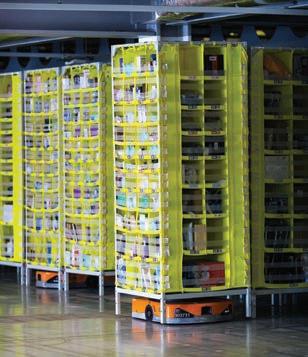
time improvements. This feedback loop forms the foundation of our safety programme.’
There are multiple ways for associates to raise safety concerns, recognising there is a no one-sizefi ts-all approach. ‘The easiest way is to speak to a manager or the safety team, but we have systems to support each person’s personal choice, and if they want to stay anonymous they can. They can also write, email, or fl ag directly to me.’
The Voice of the Associate Board is a key engagement tool. ‘Any associate can fl ag an issue, leave their login and the management team will reply within 24 hours,’ says Rob. ‘This can be a question, comment or specifi c request for support. Associates can see the comments or replies and look up previous questions and answers.’
Amazon insists it is a safe place to work, and its fulfi lment centres are open for public tours
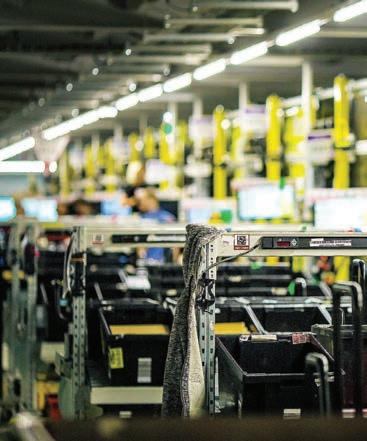
Amazon also runs a ‘Safety Saves’ competition each week. Associates submit suggestions at each FC. The associates with the best ideas each week win a prize.
‘Thousands of safety ideas, concerns, and suggestions have been shared by Amazon associates since the programme started,’ says Rob. ‘Using this invaluable and real-time insight, we’ve implemented many changes as a result of this feedback.’
Transferable skills Darren Egerton is an environmental health and safety specialist at the Tilbury FC but, like many OSH professionals, he didn’t take a traditional path. He started his career in the Metropolitan Police Service, serving for 13 years, but he swapped catching criminals for a career in health and safety two years ago as an associate and was soon presented with the opportunity to take on the role of health and safety coordinator. It became immediately clear to him that many of the skills honed in his police career would be transferable to his new safety role. ‘You could say that investigative work is still very much a part of my
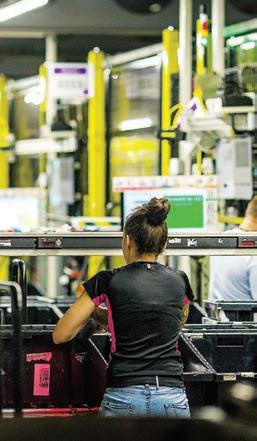
job: a safe working environment is our absolute priority,’ he explains. ‘My role requires a forensic eye for detail, the ability to listen carefully, and respond quickly. Like police offi cers, we also have to communicate with our community. We instil a safety-fi rst culture, where everyone constantly provides feedback so we can test and refi ne our processes.’ With a number of safety qualifi cations under his belt, Darren has been promoted and is getting stuck into his new role. He says that the foundation of Amazon’s safety programme is the team’s focus on driving continuous improvements. ‘To be honest, I absolutely love a safety walk. It is very similar to community engagement on the police beat. Every day, I make a conscious effort to get away from the desk and ensure I am around the fulfi lment centre speaking to colleagues, making observations, listening to feedback and trying to fi nd ways to make improvements, big and small.’
BEHIND THE HEADLINES ACCIDENTS AT AMAZON
Hundreds of people have been injured or narrowly escaped harm at Amazon in the past three years, Freedom of Information requests from the GMB union show. And annual accident rates appear to be rising: from 152 in 2017 to 240 in 2019, although the number of FCs has increased between 2015 and today. This raises questions about how far organisations are willing to push employees to increase production.
However, Rob Burnett sought to underline the positive safety systems Amazon employs.
Amazon said: ‘We benchmark against UK national data, published by the HSE, confi rming we have over 40% fewer injuries on average than other transportation and warehousing businesses in the UK.’ In addition, Amazon hasn’t been prosecuted for any safety breaches in the past four years.
The fi rm encourages anyone to go and see for themselves its dedication to safety by taking a tour at one of its FCs. IOSH magazine did just that and was encouraged to see a number of associates call out safety concerns throughout the tour – for example, when entering an area leading to a loading bay, a worker approached to explain we didn’t have the correct safety footwear for that area. Leaders were visibly inspecting the fl oor to evaluate safety measures and working conditions. ‘Schoolchildren aged six and up are invited to the tour – it’s that safe,’ says Rob.
So is Amazon a victim of its own success, and a press intent on scrutinising it? ‘Whether it’s exciting and newsworthy or not, Amazon is a safe place to work,’ says Rob.
What do you think? Have your say at bit.ly/ IOSH-Amazon
Strong leadership The ability to solve problems is a key skill every safety professional needs. Being able to infl uence is crucial, and it’s about engaging
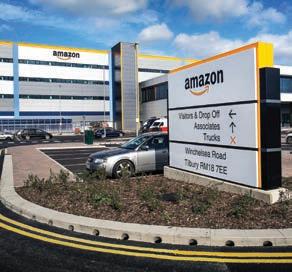
with the right stakeholders at the right level. Rob’s approach is to learn as much about a situation and its challenges as possible. ‘You can only develop knowledge in a process, and this will only continue to help you make better decisions and become a subject matter expert within the business you work in. Anyone can present some numbers or data – but forming a solution that helps support the business shows consideration around the needs and demonstrates a practical approach.’ It’s not just about quoting regulations, says Rob. You need to break them down, simplify them and tell people what they need to do and why. ‘Don’t present people with a problem: a good safety professional should be able to think and suggest ideas on what to do to resolve the issue at hand. If you can fi nd a solution by utilising stakeholder relationships and peers, you’re far more likely to be successful.’
He warns that it’s easy to get into the habit of dealing with the day-to-day safety issues and not look back and ahead. Building time in to plan and learn from your experiences as a team helps to identify the common problems that arise, the opportunities that may exist, and to design a road map to guide us on how to successfully and effi ciently complete a task. ‘A frequent question I ask myself is, what are the things I want to change in terms of process? I then use that as a starting block to make changes. I enjoy planning and try to get the UK safety leadership team together often, as it’s a great chance for us to share our successes and talk about what we’ve learned.’ For Rob, leadership is about building and equipping a team, as well as others around you, in order to trust and have faith in
managers, and it is something you have to always work on.
‘I am always looking at leaders within Amazon who have come from different backgrounds and experiences to see how they approach problems and situations,’ he explains. ‘Benchmarking your leadership style against others is a great way to identify and build a better toolkit for yourself. You have to be able to adapt and learn as you go.’
Management skills The need for safety practitioners to have wider skills and behaviours beyond technical ability, and to understand what that means for business is vital, warns Rob.
‘It all comes down to each person’s toolkit and day-to-day roles,’ he says. ‘You have to be able to manage yourself as a fi rst step. Determine where you can add value and what scope you want to take on, and consider where to fi nd the team members you think will perform the best. One of my management mentors once said to me: “It’s like playing chess: you constantly move your people based on the challenges you see.”’
Rob has tried to fi nd passion projects to balance alongside the day to day. ‘This pushes me into learning something new or allows me to use my skill-sets beyond the traditional aspects.’
As a leader, the important thing is to continue developing. ‘At Amazon, we have a phrase: “It’s always day one.” There is always something new to learn as the business grows. If you continue to build your toolkit in terms of skills and learn from the managers and leaders you have been exposed to, including the ones that were not effective, you will develop those skills to be successful.’ Amazon has also introduced Career Choice, an education programme that pays 95% of tuition and associated fees for permanent employees to undertake nationally recognised courses and funds up to £8000 over four years.
Another programme to upskill the workforce is Amazon’s safety apprentice scheme, which is about to enter its second year with 31 applicants.
‘We are working with an external provider to help build the skill-set of safety coordinators at entry level, building a developed skill-set that contains not only OSH entry-level knowledge, but the built-in bespoke skills a safety professional needs,’ explains Rob.
Feedback on the course has been positive, particularly the mix between classroom and sitebased study. Emma Horton, an OSH coordinator at Tilbury FC, joined the scheme last year. ‘[The mix] allows me to apply my study to my day-to-day work activity. I enjoy the case studies as it makes you dig into safety law and then apply it practically.’
‘This safety-fi rst approach, accompanied by smart use of technology and cultivating a feedback culture, means we can work together to improve and deliver workplace safety excellence.’ Open dialogue and regular communication with associates are aimed at building a safety-fi rst culture Through the safety lens ‘We walk the walk and talk the talk on workplace health and safety, every day,’ says Rob. ‘We strive to deliver safety by design a lot at Amazon.’
What does he mean? ‘As we consistently explore new technologies and look to innovate, when we build a new facility we think through the safety lens from the very start – at the design stage.
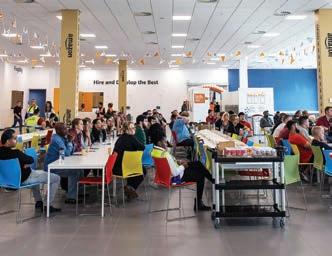
AMAZON IN NUMBERS
12 HOURS The average amount of annual OSH training per person in UK Amazon FCs
100 health and safety professionals work across Amazon’s UK network
260 meetings start each shift across the entire UK FC network with a daily safety tip
Amazon has qualifi ed fi rst aiders working across its UK FCs 400
238,000
The total number of hours of health and safety training given to staff working across UK FCs in 2018









